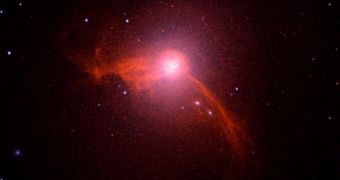Deep within the recesses of the elliptical galaxy M87 lies the largest and heaviest black hole sever discovered in the known Universe. The object is a supermassive dark behemoth, that has recently been imaged in great detail by astronomers.
The host galaxy, Messier 87, or Virgo A, is located inside the Virgo Cluster, which lies some 50 million light-years away from Earth. As such, it is close enough to home to allow for in-depth studies using ground-based telescopes.
The black hole at the core of M87 is so strong, that it contributes to the formation of an active galactic nucleus (AGN), of the type that astrophysicists only managed to identify in far away galaxies, that existed when the Universe was just a fraction of its current age.
In a recent study, experts used the NASA Chandra X-ray Observatory to look at the emissions the black hole produced. This helped experts gain a deeper insight into the structure and chemical composition of the object. Understanding it could unlock a series of mysteries related to black holes in general.
According tp the new Chandra data, the supermassive black hole at the core of M87 tips the scales at about 6.6 billion times the mass of the Sun. For comparison, the entire Milky Way weighs 100 billion solar masses.
Also compared to our galaxy, M87 features no less than 12,000 orbiting globular clusters around it, whereas our galaxy only has between 150 and 200 such structures orbiting it. The number present around Virgo A is abnormally high, experts agree.
Using data from Chandra and the Mauna Kea, Hawaii-based Frederick C. Gillett Gemini Telescope, investigators from the University of Texas in Austin, established that the black hole in M87 is several times larger than Milky Way's, which weighs “only” 4 million solar masses.
Expert astronomer Karl Gebhardt, the leader of the research group, explains that the event horizon around the supermassive black hole is so large, that it could literally swallow our entire solar system in a single gulp. It's estimated that it diameter reaches 20 billion kilometers.
In the near future, astrophysicists hope to become able to see the supermassive black hole at the center of M87. Due to its close proximity, the object will undoubtedly become the target of the newest detection methods aimed at finding Hawking radiations or other types of emissions.
These forms of radiation have been proposed by esteemed physicist Stephen Hawking a few decades ago, but thus far no one has been able to confirm their existence. However, various detection methods have been set up to find these elusive emissions, Daily Galaxy reports.

 14 DAY TRIAL //
14 DAY TRIAL //